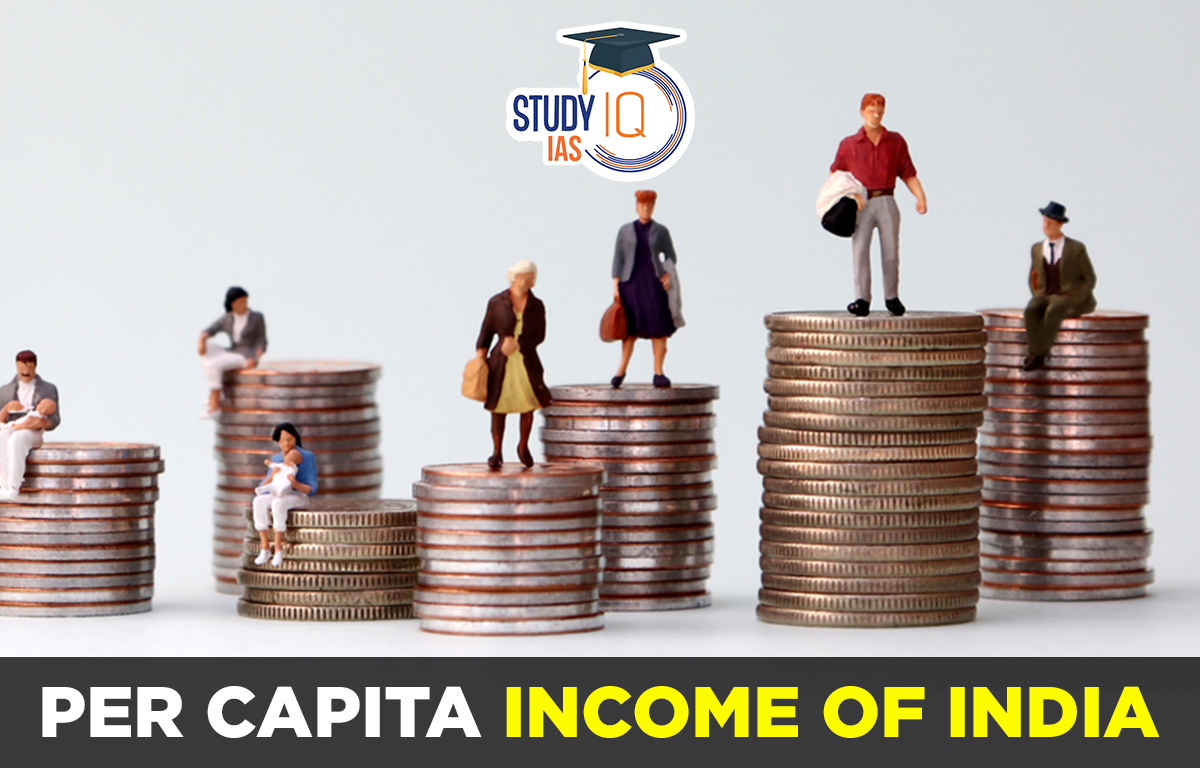Table of Contents
Per capita income (PCI) is a key economic indicator that reflects the average income earned per person in a given area. It is an important measure for assessing the economic performance of a country or region and helps in understanding the standard of living of its residents. In India, PCI plays a significant role in evaluating economic disparities across states and in formulating policies for balanced regional development.
What is Per Capita Income of India?
Per Capita Income of India is a measure of the average income earned by an individual in India within one year. The Per Capita Income of India is calculated by dividing the National Income of India by its total population. Per Capita Income of India is an important measure of its development. It is an indicator of the standard of living in the country. Per Capita Income of India forms the basis of policymaking in various sectors of the economy.
It is a very important topic in UPSC CSE 2024 of India’s Economy. We have discussed the Per capita Income of India in rupees and the calculation method of per capita income of India.
Per Capita Income of India in Rupees
As per the latest provisional estimate published on 31st May 2023, India’s per capita Net National Income (NNI) at constant (2011-12) prices increased by 35.12 per cent from Rs. 72,805 in 2014-15 to Rs. 98,374 in 2022-23. Per capita income of India in rupees was around 170 thousand rupees in the financial year 2023.
The annual growth rate was 13.7 per cent as compared to the previous year. The India Financial Year wise Average Inflation Rate based on the All India Consumer Price Index and the growth in per capita income from 2014-15 to 2022-23 is given below:
| CPI Base 2012=100 | Growth rate of Per Capita NNI (In %) | ||
| Year | Inflation based on CPI | At Current Prices | At Constant (2011-12) Prices |
| 2014-15 | 5.93 | 9.5 | 6.2 |
| 2015-16 | 4.91 | 9.4 | 6.7 |
| 2016-17 | 4.52 | 10.6 | 6.9 |
| 2017-18 | 3.59 | 9.9 | 5.5 |
| 2018-19 | 3.41 | 9.3 | 5.2 |
| 2019-20 | 4.77 | 5.1 | 2.5 |
| 2020-21 | 6.16 | -4.0(2nd RE) | -8.9(2nd RE) |
| 2021-22 | 5.51 | 16.9(1st RE) | 7.6(1st RE) |
| 2022-23 | 6.65 | 16.0(PE) | 6.3(PE) |
Second Advance Estimates of National Income and Expenditure Components of GDP, 2022-23 (at 2011- 12 Prices)
| Per Capita Income, Product, and Final Consumption | |||||
| Item | 2020-21(Second Revised Estimates) | 2021-22(First Revised Estimates) | 2022-23(Second Advanced Estimates) | Percentage change over previous year | |
| 2021-22 | 2022-23 | ||||
| Population (in million) | 1355 | 1369 | 1383 | ||
| Per capita GDP (INR) | 100,981 | 109,060 | 115,490 | 8.0% | 5.9% |
| Per capita GNI (INR) | 99,578 | 106,822 | 113,144 | 7.3% | 5.9% |
| Per capita NNI (INR) | 86,054 | 92,583 | 98,118 | 7.6% | 6.0% |
| Per capita PFCE (INR) | 57,728 | 63,595 | 67,555 | 10.2% | 6.2% |
We’re now on WhatsApp. Click to Join
Per Capita Income of India History
- India has historically been a prosperous land, dominating world trade. However, the dominating position of India drastically changed during colonial times.
- The advent of the Britishers and the establishment of their rule, especially after the Battle of Plassey, made India into a supplier of raw materials and a consumer of finished products.
- British Policy of Economic Imperialism led to heavy duty on exports of finished products of India.
- At the same time, British-made goods flooded the Indian market as they were much cheaper than locally-made goods.
- This was due to mechanized production and the Industrial Revolution in Britain.
- Indian Intelligentsia was quick to notice this process which was pushing India towards economic backwardness.
- The first attempt by an Indian to measure the Per Capita Income of India was made by Dadabhai Naoroji.
- He wrote a detailed critique of the economic exploitation of India by Britisher in his book titled “Poverty and Unbritish Rule in India”.
- In this book, he gave “drain of wealth theory” which describes how Indian wealth was being drained out.
- According to his calculations, the per capita income of India in 1867-68 was Rs. 20. Other prominent Indian economists to calculated the per capita income of India during the pre-independence time included VKRV Rao, R. C. Dutt and William Digby.
- However, these early economists had their limitations for the collection of data, access to accurate data etc.
- Hence, their calculations were crude and their methodology less refined.
- Even before independence, institutes like the Indian Statistical Institute in Calcutta were set up, but they were working under the British setup.
- After independence, the quality of data collection, and the number of institutions involved in the process increased.
- Calculation of the Per Capita Income of India became an annual exercise.
- These figures became an indispensable part of the Economic Survey and the annual Union Budget.
Calculation Method of India Per Capita Income
Per Capita Income is determined by dividing National Income by the total population of India. The National Income of India is sum total of the monetary value of goods and services that are produced in India within a period of one year. National Income is determined by three methods, which include:
- Product Method: In this method, National Income is calculated by taking the monetary value of all goods and services produced by the three sectors of the economy which include the primary sector, secondary sector and tertiary sector.
- Income Method: In this method, National Income is calculated by taking the sum total of income generated by all Individuals and Companies before they are taxed.
- Expenditure Method: In this method, National Income is calculated using the formula C + I+ G (X – M) where C is consumer spending, I is investments, G is government spending, M is imports and X is exports.
The calculation of Per Capita Income in India is done by the Central Statistical Organization. Other Institutions like RBI also publish their estimates. International organizations like the International Monetary Fund and World Bank also publish these data periodically for most countries of the world.
Per Capita Income of India Previous Years Data
| Year | Nominal GDP per capita ($) at Current Price | Nominal GDP per capita ($) at Constant Price |
| 2020 | 1,901 | 1,966 |
| 2019 | 2,101 | 2,152 |
| 2018 | 1,997 | 2,090 |
| 2017 | 1,981 | 1,982 |
| 2016 | 1,733 | 1,876 |
| 2015 | 1,606 | 1,752 |
| 2014 | 1,574 | 1,640 |
| 2013 | 1,450 | 1,545 |
| 2012 | 1,444 | 1,469 |
| 2011 | 1,458 | 1,410 |
| 2010 | 1,358 | 1,358 |
Per Capita Income of Indian States wise List
As of the latest available data (2023-24), here’s the state-wise breakdown of Net State Domestic Product (NSDP) per capita in India:
| Rank | State/Union Territory | NSDP per capita (₹) | Change (2022-23) |
|---|---|---|---|
| 1 | Sikkim | 587,743 | +12.9% |
| 2 | Goa | NA | NA |
| 3 | Delhi | 461,910 | +7.4% |
| 4 | Chandigarh | NA | NA |
| 5 | Telangana | 356,564 | +14.1% |
| 6 | Karnataka | 332,926 | +9.3% |
| 7 | Haryana | 325,759 | +9.8% |
| 8 | Tamil Nadu | 315,220 | +13.5% |
| 9 | Gujarat | NA | NA |
| 10 | Andaman and Nicobar Islands | NA | NA |
| 11 | Kerala | 281,001 | +11.2% |
| 12 | Maharashtra | 277,603 | +10% |
| 13 | Puducherry | 262,166 | +6.9% |
| 14 | Uttarakhand | 260,201 | +12.6% |
| 15 | Andhra Pradesh | 242,479 | +10.3% |
| 16 | Himachal Pradesh | 235,199 | +7.5% |
| 17 | Mizoram | NA | NA |
| 18 | Arunachal Pradesh | NA | NA |
| 19 | Punjab | 196,505 | +8.2% |
| 20 | Tripura | 177,723 | +12.9% |
| 21 | Rajasthan | 167,964 | +11.5% |
| 22 | Nagaland | NA | NA |
| 23 | Odisha | 163,101 | +13.4% |
| 24 | West Bengal | 154,119 | +10.5% |
| 25 | Chhattisgarh | 147,361 | +7.3% |
| 26 | Madhya Pradesh | 142,565 | +8% |
| 27 | Jammu and Kashmir | 142,138 | +8.9% |
| 28 | Meghalaya | 136,948 | +10.5% |
| 29 | Assam | 135,787 | +13.8% |
| 30 | Manipur | NA | NA |
| 31 | Jharkhand | 105,274 | +9.1% |
| 32 | Uttar Pradesh | 93,514 | +11.8% |
| 33 | Bihar | 60,337 | +12.8% |
Highest Per Capita Income State in India
As of the latest data for the financial year 2023-24, Sikkim has the highest per capita income in India, with a net state domestic product (NSDP) per capita of approximately ₹587,743. Here are the top five states/union territories by per capita income:
- Sikkim: ₹587,743
- Goa: ₹492,648 (latest data not available for 2023-24)
- Delhi: ₹461,910
- Chandigarh: ₹399,654 (latest data not available for 2023-24)
- Telangana: ₹356,564
These figures indicate a significant increase in per capita income compared to previous years, reflecting economic growth in these regions.
Per Capita Income of India Significance
Measurement of the Per Capita Income of India is important to gauge the level of development in India as a whole as well as within each of its states. Sector-wise calculations of Gross Domestic Product help the government and policymakers to demarcate areas where India or any of its states has a comparative advantage and areas where it is lagging behind. For the private sector, Per Capita Income is a good indicator of the investment potential of a region. It is reflective of the spending capacity of the population. Thus, one can say that regions with higher Per Capita Income exert higher centripetal forces on capital and human resources.
Per Capita Income of India Shortcomings
Per Capita Income as a measure of development is often criticized because it is a central tendency measure. It fails to capture the inequality prevalent within a region. For example, although Goa has the highest Per Capita Income among the states in India, there are variations in the Per Capita Income of North Goa and South Goa. Per Capita Income as a measure of development is less comprehensive as it fails to capture important aspects of development like health, education, and women empowerment directly.
Thus, a country or a region can have a high Per Capita Income, yet Human Development may be low there. This can be observed in Middle East countries like Saudi Arabia. Per Capita Income as a development indicator is often criticized by environmentalists as it promotes unrestricted exploitation of resources even at the expense of the environment. It fails to promote sustainable development.
Per Capita Income of India UPSC
Per Capita Income in India is a measure of the average income earned by an individual in India within a period of one year. Measurement of the Per Capita Income of India is important to gauge the level of development in India as a whole as well as within each of its states. Per Capita Income is determined by dividing National Income by the total population of India. The National Income of India is sum total of the monetary value of goods and services that are produced in India within a period of one year. The calculation of Per Capita Income in India is done by the Central Statistical Organization. Other Institutions like RBI also publish their estimates.
| Other Important Articles | |
| Minimum Support Price | Fiscal Policy |
| Finance Ministers of India List | India Ranking in Different Indexes |


 What is Visible and Invisible Trade with...
What is Visible and Invisible Trade with...
 Chemical Industry in India: Powering Ind...
Chemical Industry in India: Powering Ind...





















